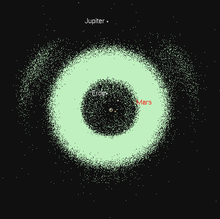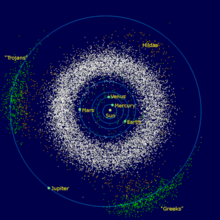Trojans (astronomy)
The two groups of asteroids that orbit the sun on the same orbit as Jupiter , but lead or follow it on the libration or Lagrange points with a mean distance of 60 ° on the Lagrange point L 4 , were originally referred to as Trojans (L 5 ). These equilibrium points represent a special case of the otherwise only numerically solvable three-body problem. The sun - planet - Trojan horse system forms a stable three-body system for each of these small bodies. When such bodies were also found on other planets, the term Trojan was extended to all comparable co-orbital objects .
The Trojans found so far are named after the people from Homer's Iliad : the leading asteroids (except for Hector ) after the Greek, the lagging (except for (617) Patroclus ) after the Trojan heroes.
Trojans from planets
Only Mercury and Saturn have not yet discovered any Trojans on the planets .
Venus Trojans and Companions
In July 2013, a Trojan was first found on Venus , which was named 2013 ND 15 . Previously, since 2001, the quasi-satellites (322756) 2001 CK 32 , (524522) 2002 VE 68 and 2012 XE 133 have been found . The 2013 ND 15 , which is less than 100 meters in size , was identified as the first true Venus Trojan, but the asteroid will leave its Trojan orbit again within about 500 years and become a quasi-satellite again.
Earth Trojans and Companions
From the ground only a Trojan is known to date, in July 2011, the asteroid was 2010 TK 7 identified as a Trojan. There is also the asteroid 2002 AA 29 , which oscillates back and forth between the Lagrangian points L 4 and L 5 . According to the collision theory describing the origin of the moon , the protoplanet Theia developed in the L 4 point of the earth's orbit , which caused the moon to form through a subsequent collision with the earth.
Mars trojan
In 1990, a Trojan was discovered at the libration point L 5 of Mars , which was named Eureka . In the meantime eight other Mars Trojans are known: (101429) 1998 VF 31 , (311999) 2007 NS 2 , 2001 DH47 , 2011 SC191 , 2011 UN63 , 2011 SL25 , 2011 UB256 and (121514) 1999 UJ 7 , of which the latter was in the L 4 point discovered. So far, however, only the four numbered ones have been confirmed by the Minor Planet Center . With the exception of (101429) 1998 VF 31 and (121514) 1999 UJ 7 all have similar orbit elements and could form a family around Eureka.
(Jupiter) Trojans

So far, Jupiter has known 4,188 Trojans in point L 4 and 2,268 Trojans in point L 5 (as of January 24, 2017) . The order of magnitude of the total number should be comparable to that of the main belt, but because of the greater distance only a smaller part has been discovered than in the main belt. The first Trojan, (588) Achilles , was discovered by Max Wolf in 1906 . By far the largest Trojan horse is probably the (624) Hector discovered in 1907 , an irregularly shaped asteroid 370 by 195 kilometers in size.
Due to its dominant mass, Jupiter has an enormous influence on the outer solar system and causes numerous instabilities in the asteroids and their orbits . Many astronomers therefore believe that a steady, slow change is taking place in the area of Trojans as well.
Their number, which is unexpectedly high today - only 20 were known in 1960 - is explained by mutual collisions. Because they have albedos around 0.04 and are similarly dark or dark red to the asteroids of the outer solar system, many Trojans presumably originate from there, i.e. they once belonged to the Trans- Neptunian Objects (TNO).
Occasionally, Trojans are likely to detach themselves from the libration points (Lagrange points) due to orbit disruptions or impacts and drift off towards Mars orbit .
Uranus Trojan
In the middle of 2013, the only Trojan horse to date was discovered that circles the sun on the Uranus orbit. The asteroid 2011 QF 99 has been ahead of its planet on libration point L 4 for at least 700,000 years and will maintain its position for approximately the next 1,000,000 years. After that, he will become a centaur again. The discovery of the 60-kilometer-wide asteroid made of ice and rock caused a surprise among experts, as it was previously assumed that no Uranus Trojans could exist due to the gravitational influence of Jupiter and Neptune.
Neptune Trojan
At the end of 2001 a Trojan was found 60 degrees before Neptune . Taken with the 4 m reflector telescope at Cerro Tololo , the 230 km body was given the asteroid number 2001 QR 322 , but was only "secured" after a year. It orbits the sun - just like Neptune - in 166 earth years. In the meantime, 8 other Neptune Trojans are known: (385571) Otrera , 2005 TN 53 , (385695) Clete , 2006 RJ 103 , (527604) 2007 VL 305 as well as 2004 KV 18 , 2008 LC 18 and 2011 HM 102 . The first six are all on L 4 , the last three on L 5 .
Originally, the L 4 position was also adopted from 2008 LC 18 . However, on August 12, 2010, the Department of Terrestrial Magnetism (DTM) of the Carnegie Institution of Washington in Washington D. C. announced that in 2008 LC 18 was moving to the Lagrangian position L 5 . It is the first detected Neptune Trojan in this position.
On 25/26 August 2014 the New Horizons space probe crossed Neptune's orbit not too far from Lagrangian point L 5 . However, the probe was too far away to observe the Neptune Trojans, see for example 2011 HM102 .
The Neptune Trojans are said to be named after Amazons .
Trojans of moons
A Trojan moon is a natural satellite of a planet that moves in one of the libration or Lagrange points of a larger moon. The Trojan moons are a subset of the co-orbital moons .
Currently, four Trojan moons are known, all in lunar system of the planet Saturn are:
- the Saturn moon Tethys is accompanied on its orbit by the two smaller moons Telesto ( Lagrange point L 4 ) and Calypso (L 5 point);
- the Saturn moon Dione shares its orbit with the two smaller moons Helene (L 4 point) and Polydeuces (L 5 point).
Very weak dust clouds were found in the L 4 and L 5 points of the orbit of the Earth's moon , the Kordylewsk clouds (confirmed in 2018) , which are even weaker than the weak counter- evidence.
Moons of Trojans
In the case of the Jupiter Trojan (617) Patroclus , which moves on the Lagrange point L 5 , a moon of a Trojan was first discovered on September 22, 2001 and named Menoetius . Both bodies move on circular paths around the common center of gravity.
Since then, three more moons orbiting Jupiter's Trojans have been detected, namely the L 5 Trojans (17365) 1978 VF 11 and (29314) Eurydamas and the L 4 Trojans (624) Hektor .
See also
Web links
|
Further content in the sister projects of Wikipedia:
|
||
|
|
Commons | - multimedia content |
|
|
Wiktionary | - Dictionary entries |
- Sternenbote : year 45/12, pages 222–234: The asteroids - drama and rubble in the planetary system: Gottfried Gerstbach: Articleavailableas PDF on the author'swebsite: g.gerstbach.at (PDF; 532 kB)
- List of all Trojans at www.cfa.harvard.edu (English)
- Christian Pinter: The Trojans of Space - Wiener Zeitung , December 28, 2007
- First Neptune Trojan at kuffner-sternwarte.at
- Asteroids with identity problems - A (double) trojan of Jupiter is possibly a comet - News article from February 4, 2006 on Wissenschaft.de
Individual evidence
- ↑ Solar system: Astronomers find new Mars Trojan. In: Spiegel Online . July 25, 2007, accessed February 27, 2015 .
- ^ A b Matija Ćuk, Apostolos A. Christou, Douglas P. Hamilton: Yarkovsky-Driven Spreading of the Eureka Family of Mars Trojans. arxiv : 1412.1776
- ↑ List of the MPC
- ↑ Fumi Yoshida, Tsuko Nakamura: Size distribution of faint L4 Trojan asteroids . In: The Astronomical journal . 130, No. 6, 2005, pp. 2900-11. bibcode : 2005AJ .... 130.2900Y . doi : 10.1086 / 497571 .
- ↑ Mike Alexandersen, Brett Gladman, Sarah Greenstreet, JJ Kavelaars, Jean-Marc Petit, Stephen Gwyn: A Uranian Trojan and the frequency of temporary giant-planet co-orbitals . In: Science . tape 341 , no. 6149 , August 30, 2013, p. 994-997 , doi : 10.1126 / science.1238072 , PMID 23990557 .
- ^ Trojan Asteroid Found in Neptune's Trailing Gravitational Stability Zone. Carnegie Institution of Washington , Washington DC, press release dated April 12, 2010. Retrieved November 28, 2010.
- ^ Working Group for Small Body Nomenclature
